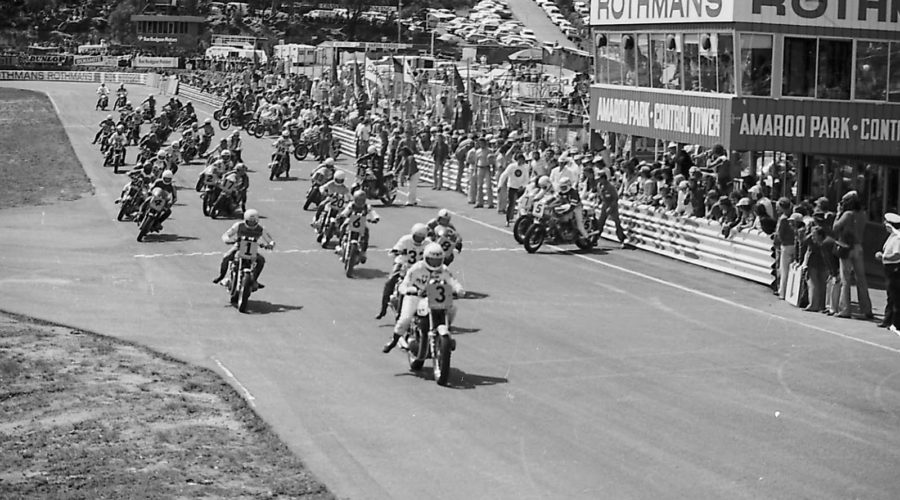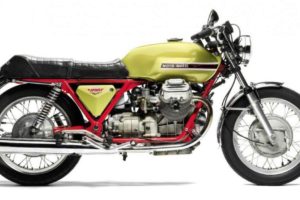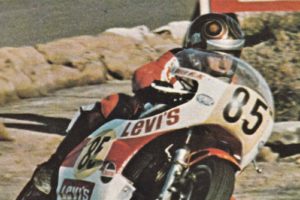The 1976 Castrol Six-Hour Race
Let the record show that the Team Avon Kawasaki Z1 of Jim Budd and Roger Heyes won the fastest and closest-ever Castrol Six Hour Race. And that the second placed team of Tony Hatton and Ken Blake were just eight seconds in arrears on their BMW R90S, on the same lap as the leaders, with the third placed 900SS Ducati of Dan Oakhill and Ross Pink seven seconds behind the BMW, and also on the same lap, with the fourth-placed Z650 Kawasaki of Rob Madden and Alan Hales just 25 seconds behind them – on the same lap as well!
Perhaps the most incident-packed Castrol ever, with three different makes in the first four and only half a lap separating them.
But if ever a Six-Hour was full of behind the scenes drama (and aren’t they all?) this was the race to top them all.

The race winners were actually very fortunate to front the line. The last few moments of Saturday practice saw Heyes pelt the big Kwaka away on the entrance to the Dunlop Loop right-hander over the brow of the hill. The bike stepped out on a surface made treacherous by a sudden shower, and was removed from the circuit a written-off wreck. The night was a wild one! The badly-bent frame was replaced and new forks and swingarm fitted.

The left sidecover plate had worn almost completely through and had to be re-welded, the joint faces ground true again and the whole lot refitted. Sidecar enthusiast Peter Campbell’s workshops housed hours of solid work by a small army of volunteers, under the watchful eye of an official scrutineer.
But if Budd and Heyes’ determination was to put on a show for their sponsors, the crowd and the enthusiasts who built and repaired the bike, that inspiration was sadly lacking elsewhere.


Just an hour before the start the Cornell Suzuki GS750 was withdrawn. The bike was fifteenth fastest qualifier, with a handy lap time of 60.8 seconds, a second slower than John Warrian’s Ducati 900SS, but still nicely on the pace. It looked as though the distributors were displaying a chronic lack of faith in the product, particularly against the much-vaunted Z650 Kawasaki which was a clear .9 seconds quicker with a qualifying lap at 59.9.
But the reason for withdrawing the machine was found to be that the Top Brass had to pay to get in and so decided to take the new toy home and leave the game!
The gesture robbed the race of one of the most eagerly-awaited machines and allowed the Z650 Kwaka to be the sensation of the event, finishing a brilliant fourth place just half a lap behind the winners.
There were other dramatic incidents; one of them involving the ill-fated return to racing by two-time winner Bryan Hindle. A week before in practice, Hindle’s R90S BMW locked solid on the Honda corner exit.

The day before the event Hindle told us he had lost two seconds a lap as a result of the prang, and he doubted he could pick them up again. On raceday he was still being helped into his leathers. He didn’t look very happy, but displayed the guts of which champions are made by fronting the line and riding as hard as his state of mind allowed. He was just off the pace with his lap times, but the pit crew kept him up to scratch with some very reassuring, cryptic messages.
His co-rider, German Helmut Dahne, showed the crowd a fine clean style and some red-hot laps, but the team couldn’t manage miracles. They ended the race in fifth spot, just one lap behind the leaders.

Second place riders Tony Hatton and Ken Blake were unfortunate not to have won the event outright, because the clutch on the Boomer began to slip just half an hour into the event and they lost some little time for over an hour as a result. Ken told us the clutch slip made it hard to hose off the German rider because he was forced to ride a gear higher in most places and to apply the throttle with uncharacteristic gentleness.
They pressed on regardless and made a swift clutch adjustment when riders were changed, and the problem quietly disappeared. Hatton was timed unofficially on two or three laps at 59.5 seconds with no traffic about – but the BMW is not supposed to be quite as quick as that!
The Joe Eastmure/Dave Burgess team was at least as unfortunate, because their R90S was clearly faster than the other two teams’ and they actually led the event for a time.

Both riders were timed by us with the odd lap at 60 seconds and one at 59.8, and their times were consistently good – the sort of riding which wins long-distance events. The bike was flying, Eastmure in particular enjoying the event in hang-it-all-out style.
We spoke to him before the race about his chances. “I’ll go as fast as I can consistent with enjoying myself. We are two-tenths under the fastest lap time. That makes me feel good!” he said.
But the bike went out at two o’clock with a broken cam follower.
Fastest qualifiers John Warrian and Greg Johnson were tuned up to the minute and looking strong. The 900SS was apparently the fastest bike on the circuit, and the duo were content to hold station on second spot after Warrian had climbed to that position from a slow start.

He said he had not intended to ride the bike to the pole position but it was cracking so well, and so easily, that he “just let it go”.
Warrian clearly had the measure of the winning Kawasaki and took an easy lead when the Avon teamster pulled in for his first fuel stop.
The bike was still in the lead at 12:30 when it speared into the bank on the Dunlop Loop and flipped over. It graunched the right side of the·machine, flipped on to its back to write off the tank, fairing and seat/sub frame assembly, then flopped on to its left side to die.
Johnson was not injured, but the bike was too badly damaged to hope for any repairs. Cruel luck for Warrian in particular, who had led last year’s event until almost 20 minutes from the finish when engine troubles finished off his gallant ride.
The Hansford Z650 was expected to do well, but was returned to the pits at almost the same time as the big Ducati, its rear wheel almost out of the frame. Seven spokes had broken and the resultant wheel replacement lost the team six hard laps, not one of which they could hope – or manage – to pick up again.

Co-rider Murray Sayle was in the saddle at the time and he reported a hairy moment as he fought the bike back to a reasonable speed and trickled it back to the pits.
But with all the drama who noticed the Triumph Bonneville? It circulated with no drama, and not much chance of showing well in the final results, until a spate of rear disc-mounted fractures finished it off.
It was campaigned by Greg MacDonald and Jim Smith in what was probably a gesture of British stiff-upper-lipmanship, but was doomed by an apparent serious weakness in the disc mounting plate which fractured continually at the point where the rear spindle slides through the bracket. There was no question of the original bracket itself being a single faulty component because it was replaced with another, new component which also expired at the same area. The brackets were welded several times – we counted at least three – but continued to give precisely the same trouble.
If the also-rans were experiencing their own kind of hell, there were those in the race who had little or no trouble at all. Amongst them was the Laverda Team of John Hughes and Lindsay McKay campaigning the biggest machine in the race, the 3CL1000. The bike circulated steadily for 12th place with 340 laps – 12 down, or about seven and a half minutes, behind the winners.


The other Suzuki GS750 in the event was ridden with no drama by the Phil Jacobs/Allan Kay team, originally entered on a Kwaka 900. The bike logged 335 laps for 17th spot.
But amongst some of the more fancied runners the race was one of very mixed, and changing, fortunes. The two renowned hard-chargers Len Atlee and Gary Thomas, riding for 2SM under the Team Atlee banner, were in the thick of the action from the start, posting a good qualifying lap of 59.8 sec to place their Kawasaki 900 in fourth spot on the grid, just behind the Eastmure/Burgess entry which had posted a similar time in practice.
Thomas burst away from the start to slot into second place just ahead of Hansford, but a few seconds behind Jim Budd who had obviously decided to go like the clappers at the start and then perhaps ease the pace as the field sorted itself out a little later into the race.
Warrian took a couple of hard laps to clear himself from the slower traffic, but then began to move into contention, enjoying several skirmishes with Thomas before finally passing him – only then to be overtaken by him again! The Thomas/Len Atlee bike visibly had plenty of steam but soon began to handle strangely (not that it bothered either of them too much) with a loose rear wheel.

It was South Queensland rider Danny Oakhill who set the woods afire not long before the premature retirement of the Warrian/Johnson Ducati, his similar 900SS model sounding very crisp and actually overtaking Warrian’s machine. The bike was very fast on all sections of the circuit, in particular at the top of the hill as the bikes lined up the very fast left-hander up there, and on the exit of the double-loop out of Dunlop Corner, a vicious, off-cambered right-hander which is still one of the fastest bends on the circuit.
Danny shared the ride with fellow production race specialist Ross Pink, the two Queenslanders showing a very remarkable turn of speed. It was only the grim state of the bike’s rear tyre that stopped Oakhill’s magnificent ride at the end of the race from being totally successful.
His last hour in the saddle began well, with his effort clearly the quickest on the track until one or two fearful slides on the monster had him button off and ride with more caution to the finish.

The last dying hour was enlivened by a magnificent dice between the two R90S machines of Ken Blake and Helmut Dahne, with very little to choose between them. It transpired later that Dahne thought he was on the same lap as Blake, had in fact received a pit signal to this effect, and was dicing for what he thought was second place. It probably would have made little difference to him anyway, because he was quite obviously enjoying the private race, but he was in fifth place behind the Z650 Kawasaki and one lap down on the second-placed Blake.
The two kept the crowd on its toes as they pressed on, closing the gap to Oakhill on the sliding Ducati and also on the leader, in trouble with worn rear rubber as well.

With just over half an hour to go, the German slipped by Budd and towed Blake through with him, placing the local rider on the same lap as the leader and possibly within striking distance, for the two BMW machines were lapping faster than anything else on the track, although Oakhill was wringing the neck of his flying Ducati at every opportunity.
It was to little avail, because the Kawasaki had enough poke left to slide to the finish line and win the epic by a very narrow margin from the fast-closing Ken Blake, with the gallant Oakhill in third spot also closing.
Since its inception, the Castrol Six-Hour Race has seen two different winners of each race, in some instances three.
There is the moral victor, the one the crowd would love to see take home the gold as well as the glory, including Craig Brown the first year (1970), Joe Eastmure on the little giant-killing Suzuki 315 and John Warrian last year on the Ducati.
All were favoured with the crowd and won moral victories. They are matched by the odd few who have had the glory for a fleeting moment but ultimately not the gold. Of the latter, Hindle’s BMW victory and Joe Eastmure’s astonishing Suzuki upset probably provide the best examples.

Then, of course, there is the team which actually wins, by popular acclaim or not!
But this year’s event made history by seeing the moral victors actually declared the winners – and being able to keep the laurels after the agonising check-back of lap scoring. It is also the first time the race-winner led the field on the first lap, and indeed for much of the race.
The Avon team of Roger Heyes and Jim Budd won the event in the closest finish yet recorded. They won a major event they were lucky even to be able to start in! Jim Budd also came within an ace of dropping the Kwaka in Honda Corner during the event when he swung right off the track to miss a fallen rider.
Races have been won and lost through smaller incidents than that!
By Brian Cowan. Two Wheels, February 1977.
In 1984 the ABC made a fabulous documentary, Six Hours in History. Watch it here.





